Author: Marshall Schott
Brewer: Ed Coffey
I began pondering my plans for Homebrew Con a few months ago and quickly realized traveling across the country with beer wouldn’t be very practical. This was right around the time we published the Brü’s Views article on hazy beer, which provoked a friendly conversation between Ales Of The Riverwards‘ Ed Coffey and I about the potential impact fining might have on Northeast/New England (NE) style beers. I reminded him of the results of the first gelatin xBmt showing a fined-to-brite APA was indistinguishable from a non-fined hazy version, he responded that there are particular aspects of NE-style beer that may produce different results, namely the inclusion of a large portion of oats in the grist, which many believe is responsible for their perpetual haze. Touché. My grist included precisely zero oats, only the standard malted barley with a touch of wheat.
Over the course of the following few days, Ed’s and my curiosity about the effect of gelatin on oat-caused haze came to a head and we agreed the only prudent avenue at this juncture would be to put it through the rigors of an informally formal xBmt. We pulled Brülosophy’s hazy beer appreciating Malcolm into the fray to discuss how to approach this variable, which is when the idea of collecting data at Homebrew Con in Baltimore, MD came up. Given Malcolm’s commitment to brewing beers for our seminar, Ed offered to brew the beers using our annoyingly stringent protocol and bring them to the conference– collaborative xBmt born!
| PURPOSE |
To evaluate the qualitative differences between a gelatin fined NE-style ale made with a good portion of oats and the same beer left non-fined.
| METHODS |
After some back-and-forth between Ed, Malcolm, and I, we ultimately settled on brewing an iteration of one of Ed’s favorite NE Pale Ale recipes he calls HopWards, a play on Tired Hands Brewing’s HopHands. For a more in-depth discussion about this recipe and to read Ed’s thoughts about his clone attempt, check out his article on the Ales Of The Riverwards blog.
HopWards NE-Style Pale Ale
Recipe Details
| Batch Size | Boil Time | IBU | SRM | Est. OG | Est. FG | ABV |
|---|---|---|---|---|---|---|
| 11 gal | 60 min | 61.8 IBUs | 4.4 SRM | 1.051 | 1.013 | 5.0 % |
| Actuals | 1.051 | 1.012 | 5.1 % | |||
Fermentables
| Name | Amount | % |
|---|---|---|
| Pale Malt, Halcyon (Thomas Fawcett) | 17 lbs | 81.93 |
| Oats, Flaked | 3.75 lbs | 18.07 |
Hops
| Name | Amount | Time | Use | Form | Alpha % |
|---|---|---|---|---|---|
| Columbus (Tomahawk) | 31 g | 60 min | Boil | Pellet | 13 |
| Amarillo Gold | 37 g | 5 min | Boil | Pellet | 8.2 |
| Centennial | 37 g | 5 min | Boil | Pellet | 10 |
| Simcoe | 37 g | 5 min | Boil | Pellet | 12.3 |
| Amarillo Gold | 37 g | 20 min | Aroma | Pellet | 8.2 |
| Centennial | 37 g | 20 min | Aroma | Pellet | 10 |
| Simcoe | 37 g | 20 min | Aroma | Pellet | 13 |
| Amarillo Gold | 114 g | 5 days | Dry Hop | Pellet | 8.5 |
| Centennial | 114 g | 5 days | Dry Hop | Pellet | 10 |
| Simcoe | 114 g | 5 days | Dry Hop | Pellet | 13 |
Yeast
| Name | Lab | Attenuation | Temperature |
|---|---|---|---|
| London Ale III (1318) | Wyeast Labs | 73% | 64°F - 74°F |
Download
| Download this recipe's BeerXML file |
A couple days prior to brewing, Ed made a properly sized starter that would eventually be split between two carboys.
The brew day began with grist collection, which included only Halcyon Pale Malt and a relatively large portion of flaked oats that were added directly to the MLT without being milled.
While NE-style ales are commonly made with water that’s very high in chloride, we decided it would be best to go with a balanced water profile in order to reduce the impact it has on haziness. With the treated strike water all warmed up, Ed incorporated the grains and hit his target mash temperature.
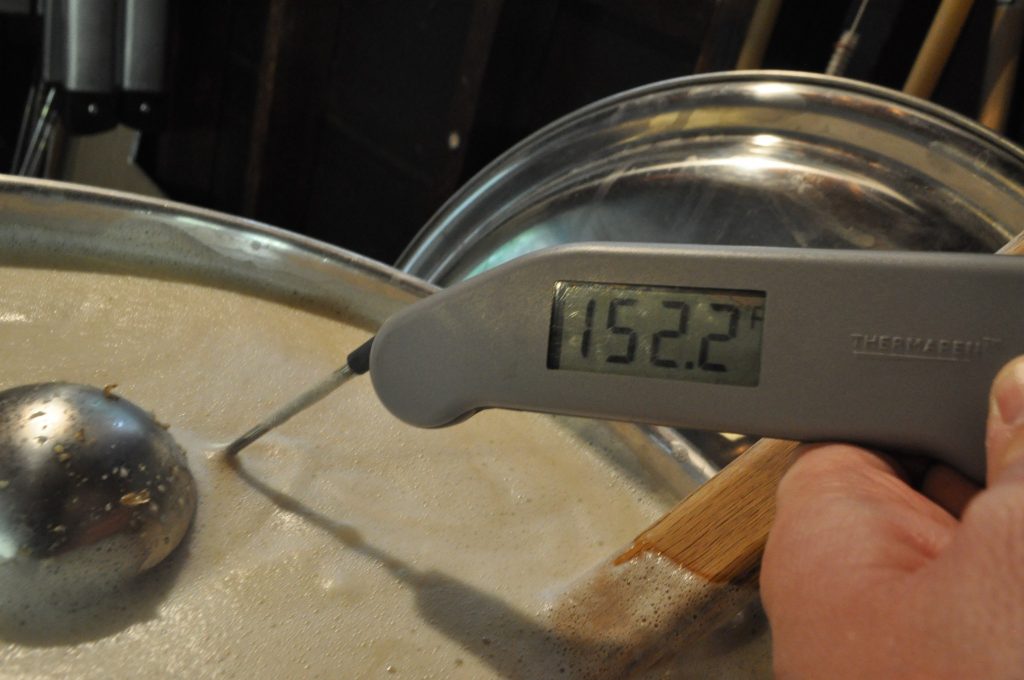
The mash was left alone for a 60 minute saccharification rest.
About 10 minutes in, a small sample was pulled and cooled so Ed could take a pH reading.
Wort was collected at the end of the mash rest and boiled for 60 minutes with hops added per Ed’s schedule, as well as two Whirlfloc tabs. It was then chilled and transferred to a single 15 gallon Speidel fermentor before the yeast was pitched. Ed let the beer ferment for a week at 66˚F/19˚C then he ramped it up to 70˚F/21˚C and let it ride until it reached a stable 1.012 FG. At this point, he cold crashed over a couple nights then racked equal amounts into two separate kegs. This is the point where the variable was introduced. Relying on the method outlined in the first gelatin xBmt that I’ve found to be quite successful, Ed combined 1/2 teaspoon powdered gelatin with 1/4 cup water and warmed it to right around 150˚F/66˚C before adding it to one of the kegs; the other keg was left alone.
The beers were left undisturbed and on gas for 3 days before Ed pressure transferred them to fresh serving kegs, leaving anything that dropped out behind. They were then loaded in his car for the 2-ish hour trek from Philadelphia, PA to Baltimore, MD. But not before pulling a couple samples to compare appearance…
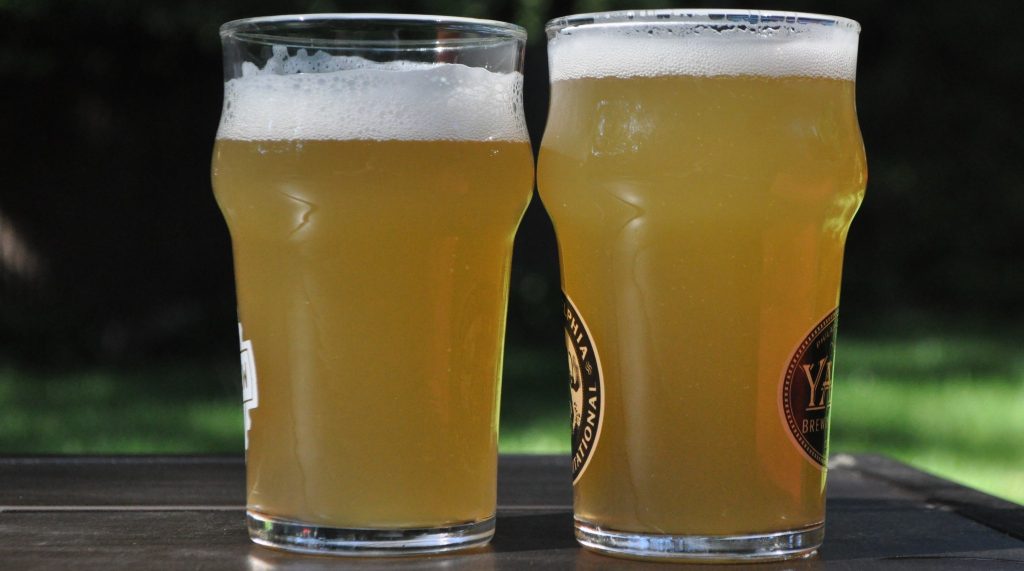
Our first finding was quite obvious– gelatin did not seem to have nearly the effect on a beer made with a large portion of flaked oats as it does on all barley beers. However, a close examination reveals the gelatin fined beer to be slightly clearer than the non-fined batch, leaving me all the more curious if tasters would detect a difference.
| RESULTS |
All of the data for this xBmt was collected during Homebrew Con 2016 in Baltimore, MD and including 45 participants of varying levels of experience. Each taster was blindly served 1 sample of the beer fined with gelatin and 2 samples of the non-fined beer in opaque cups then asked to identify the one that was different. Given the sample size, 21 tasters (p<0.05) would have had to accurately identify the unique sample in order to achieve statistical significance, though only 14 participants (p=0.68) were capable of doing so, a number almost perfectly consistent with random guessing. These findings provide further evidence that a beer fined with gelatin is indistinguishable from the same beer receiving no fining at all.
Even though our recent analysis failed to demonstrate a link between level of experience and triangle test accuracy, I thought it’d be interesting to share the results of only those participants who endorsed being a BJCP judge. A total of 23 BJCP judges of various rank participated in this xBmt, a sample size that would require 12 (p<0.05) accurate responses in order to reach significance. Six (p=0.83) accurately selected the unique sample, that’s only 23%, which is a fair degree lower than the 1/3 expected by chance alone.
My Impressions: I couldn’t tell these beers apart at all. Sometimes in non-blind side-by-side comparisons, I think I noticed a difference, but that wasn’t the case with these beers. They tasted exactly the same to me even despite knowing the variable. The fined beer was visibly clearer than the non-fined sample, but not by much. They looked more similar than they did different. As for the beer, my goodness was it hoppy. Not bitter or muddled, but enormously fragrant, to the point people walking into our hotel room during a particular tasting session commented on it, and that was mere minutes after pouring from a couple 32 oz growlers. Absolutely delicious, Ed’s HopWards recipe is one I would heartily recommend people brew!
Ed’s Impressions: Ed participated in a “blind” triangle during the conference, the data of which was not included in the analysis, and like me, he could not reliably distinguish the fined beer from the non-fined sample. For more details on what Ed thought of these beers, check out his blog for an upcoming post covering his brew day for this beer.
| DISCUSSION |
This xBmt served two main purposes, the most obvious being to test if a NE-style beer fined with gelatin would be reliably distinguishable from the same beer that was not fined with gelatin. However, a second and perhaps more interesting goal was to investigate the effect gelatin had on a beer produced with a large portion of flaked oats, an ingredient commonly used in these types of beers for its purported ability to impart a silky mouthfeel and contribute to so-called “juicy” character. Yet again, the results of this xBmt support the notion that fining with gelatin does not have an appreciably negative impact on aroma, flavor, or mouthfeel, though curiously, they also seem to show that gelatin may not perform its intended duty as well in beers brewed with a larger percentage of flaked oats. Fascinating!
As usual, I’m left with more questions than answers. Not so much about the impact gelatin has on beer quality, at this point, after so many experience confirming xBmt results, I’m comfortable accepting the fear of a negative effect is unfounded. Rather, the inability for gelatin to clear this particular beer is what interests me. What is it about flaked oats that makes it immune to the clarifying powers of gelatin? How much of the haze in popular commercial versions of NE-style beers is actually the result of flaked oats? Of the various examples I’ve tried, including Lawson’s Sip Of Sunshine and Treehouse’s Julius, there were some that had what I’ve always believed to be a yeasty component, a sort of grittiness that sticks to my teeth and makes them squeak. This is what I expect when I drink a hazy beer. Then again, there were others that, had my eyes been closed, I might have easily thought were as clear as the beers I prefer– clean, crisp, and even quite tasty.
When it comes to this newfangled style, it seems to me there’s more to it than just grist, chloride levels, and yeast alone, but rather the interplay of various factors that contribute to what has become a hot commodity among the craft beer drinking community. While my preference for clarity remains, perhaps as a manifestation of my own vanity, the results of this xBmt certainly made me reconsider some of the past judgments I’d made about hazy NE-style beers, which I suspect will allow me to evaluate them from an at least somewhat more impartial perspective.
If you’ve tried fining your NE-style ales with gelatin or anything else, particularly those including flaked oats in the grist, please share your experience in the comments section below!
Support Brülosophy In Style!
All designs are available in various colors and sizes on Amazon!
Follow Brülosophy on:
FACEBOOK | TWITTER | INSTAGRAM
If you enjoy this stuff and feel compelled to support Brulosophy.com, please check out the Support Us page for details on how you can very easily do so. Thanks!

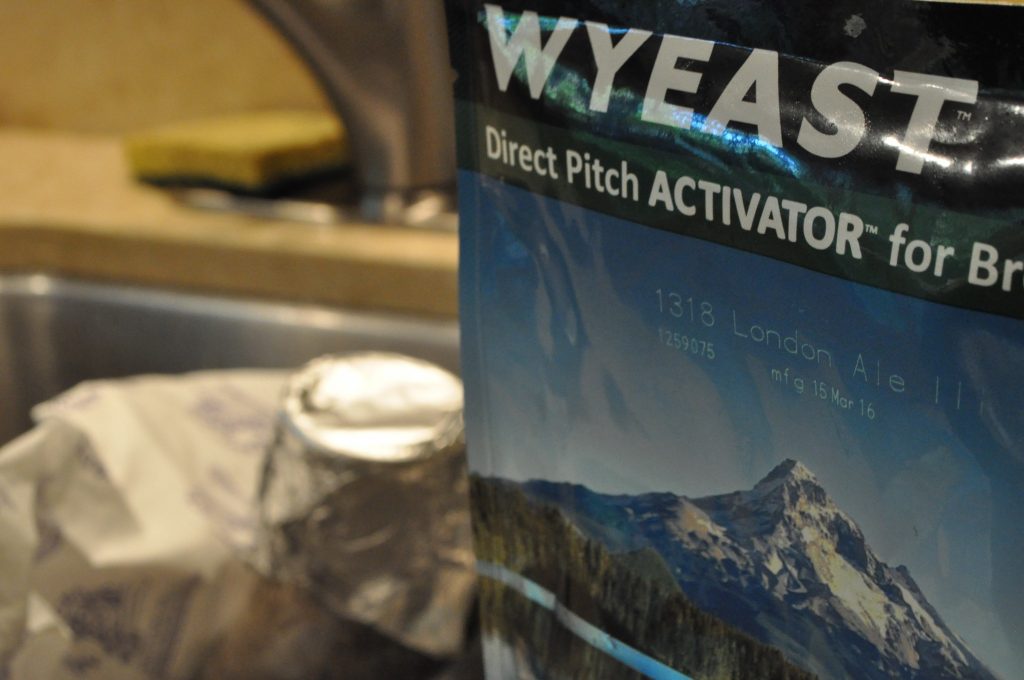
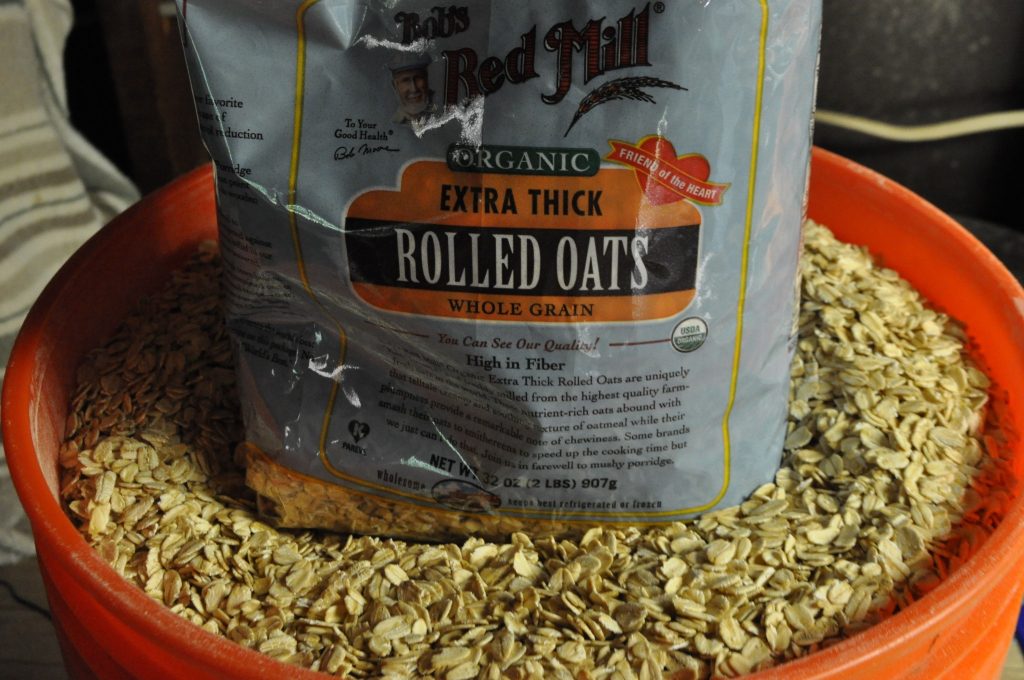
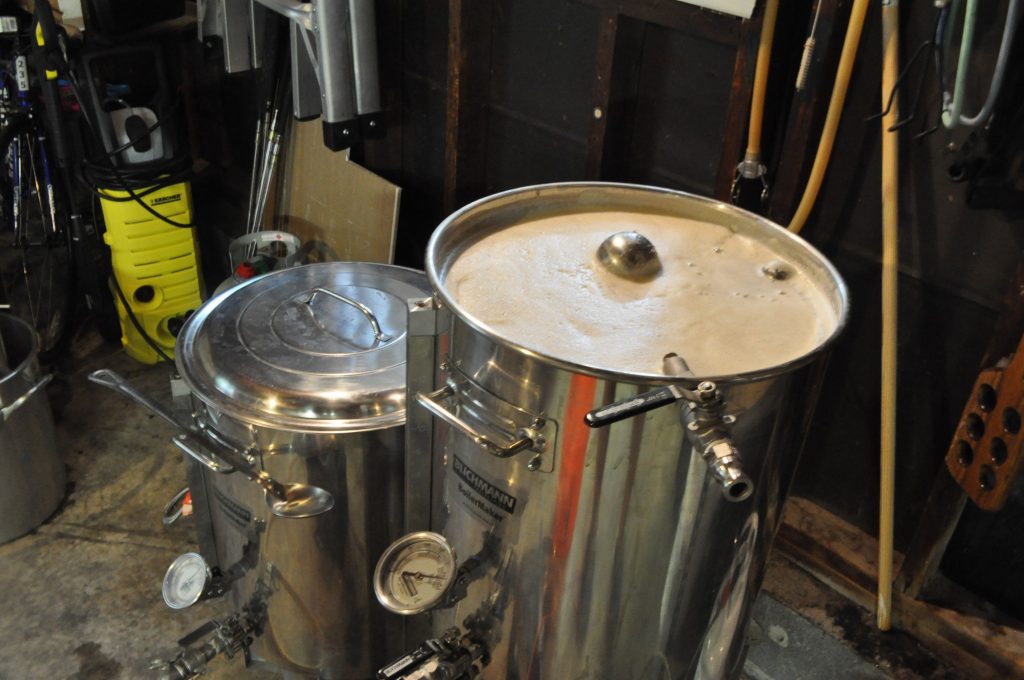
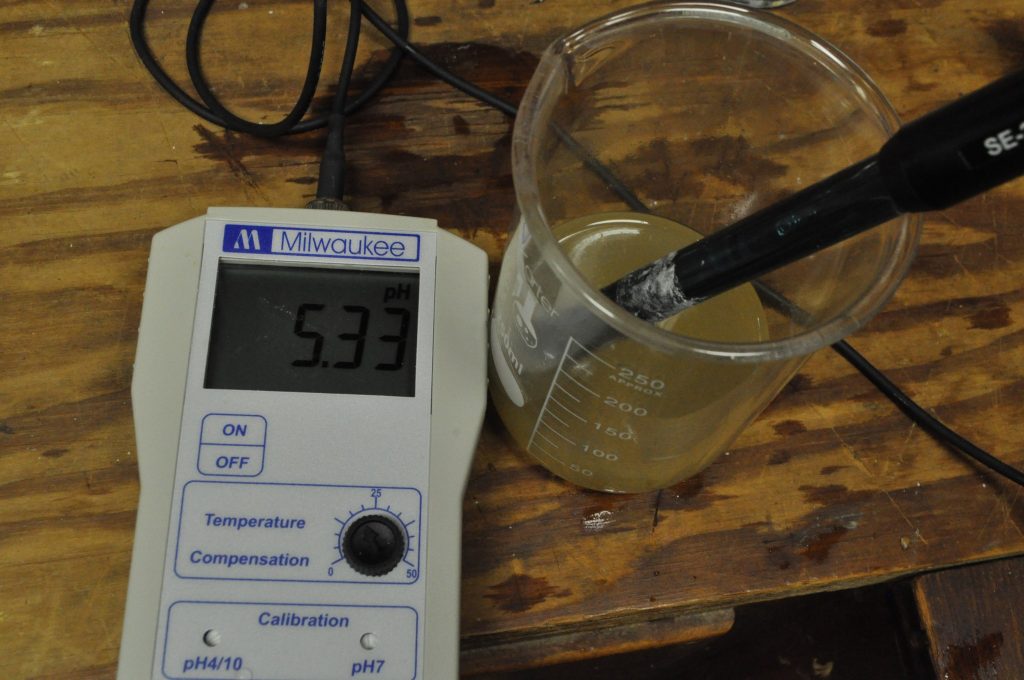
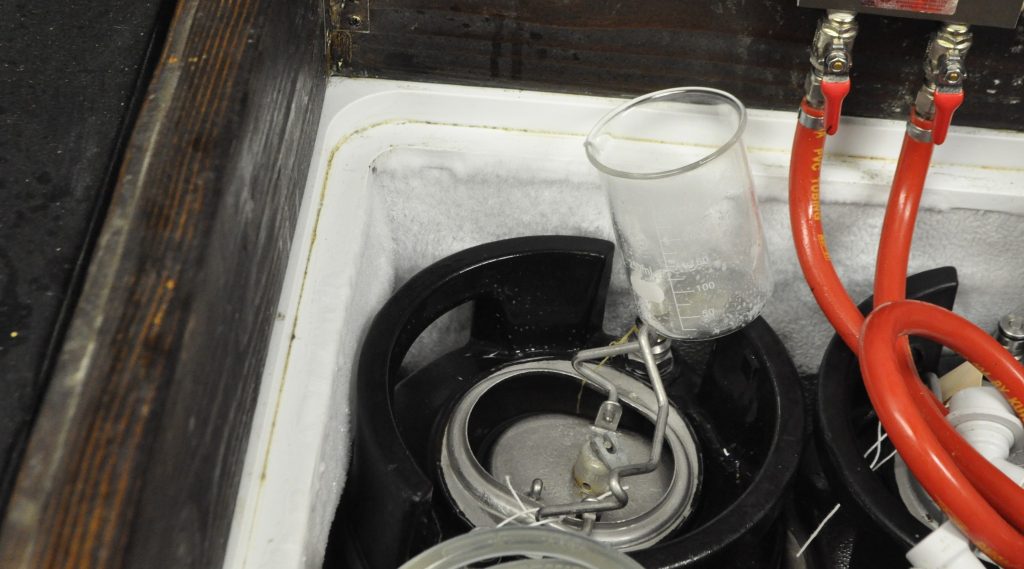










70 thoughts on “exBEERiment | The Gelatin Effect: Impact Fining With Gelatin Has On A Hazy IPA”
Cool, but I think there’s a lot of NEIPAs out there without oats (looking at you Trillium). Also, after trying Aslin this weekend I’m not even sure what the definition of a NEIPA is anymore: Aslin beers are so packed with oats/wheat/etc that they’re beyond murky… more like a pale stout jam packed with late hops.
I brewed up a couple of NEIPAs for NHC and left the lesser of the two at home, where it has sat in a keg for a while now. It is actually starting to fall clear, and interestingly enough the biggest thing I’m losing isn’t flavor, but mouthfeel. I still get the same hop flavor, but all the softness is gone and it really drinks like a different beer. This was a recipe of mostly pale with about 12% flaked wheat (was aiming for a DDH Fort Point Pale Ale type clone) and 15oz of late hops for a 5 gal batch.
Also, when did you guys introduce the dry hop? IME all the haze centers around that factor.
Very interesting. It would be interesting to repeat this experiment using SuperKleer or a similar two-stage fining agent to see if different finings can attack oat haze.
A more efficient way of evaluating these post boil fining agents would be to split a batch among mason jars, rather then doing a batch at a time. You only need to know if it affects flavor if it produces clear beer. You could split the remaining batch in 2 to perform a triangle test after picking the winner.
Any thoughts on measuring turbidity of for these XBMT? I’m not sure if it matters if you can’t see a significant difference. but it’d be interesting and another way to complicate the data.
My experience with NE IPAs is limited, but to me there is a difference is appearance and mouthfeel between a hazy beer from intense dry hopping and the sometimes nearly milky cloudiness that NE IPAs have.
Agree with Colin. If dry hop during or even at the tail end of fermentation some yeast varieties will not clear with gelatin and I haven’t used oats in any of my NEIPAs. I typically use wheat malt up to 10% of the grist.
2 Rounds of dry hops, once at the tail end of primary and once in kegs with intermittent agitation.
What a fantastic experiment. Hope you explore the phenomenon that is NE style IPAs more! Also why do NE IPAs get all kinds of blow back but styles like hefeweizen and wit beers get embraced for the haze and mouthfeel? Seems like a double standard.
When gelatin doesn’t clear my beer, I know that the remaining haze is caused by polyphenols. I then use polyclar to clear the beer. I realize this was a gelatin test and I’m only commenting for those that would like to do a side by side NE style hazy versus clear beer.
I’ve yet to use PolyClar/PVPP and really ought to pick some up for testing.
Exactly. And that’s where people get all caught up in the wrong things when making a NEIPA. It’s about the polyphenols and slightly higher FG that can provide most of the mouthfeel. It’s never been about the yeast. Go try the quintessential beers for this style…Hill Farmstead. All about mouthfeel, softness, smooth bitterness.
Interesting results, and it seems to fall in line with a recent NE-style IPA I brewed. I didn’t fine with gelatin, but the keg did sit cold in my keezer at lager temps for a couple of weeks as I was cold-conditioning a lager. It did clear up a bit, but a noticible amount of haze remained. I was hoping that some of the harshness from a large dry-hop addition would have dropped out, but alas the only flavor that seemed to fade was the tropical and citrus fruit character.
In my opinion the cause of haze in beers termed as “New England” style IPA is not clearly known. I have read people theorize aspects like: yeast strain, flaked grains, hop polyphenols, etc.
With that out of the way I think it is wise to consider that gelatin reportedly reacts differently with various yeast strains; below are extract from BYO’s Mr. Wizard (Ashton Lewis) in a BYO of November 2004:
“This is especially true of yeast because different strains vary in flocculation and respond differently to collagen finings (gelatin and isinglass).”
“Gelatin is also rich in collagen, but it is not as pure as isinglass and is not as effective at removing yeast.”
“Not all yeast respond the same to this method of fining because not all strains have the same density of negative charges on the cell wall.”
I would suggest that it is a possibility that the utilization of gelatin in a “New England” style IPA that is brewed using the Wyeast 1318 yeast strain may not result in a cleat beer but perhaps gelatin would be more effective for a differing yeast strain. Maybe if the same beer was brewed using Wyeast 1098 (WLP007) gelatin might be more effective in clearing the beer?
Cheers!
WLP007 is the primary yeast strain I use for NEIPAs. It is also the yeast strain that many suspect trillium uses. I tried adding gelatin to one of the two kegs twice with no luck getting the beer to drop clear. The beer turned out fantastic so I’ve grown to love my hazy IPA – dry hopped with 1.5 oz/gal.
The haziness could also be from the super high amounts of dry hops. I recently made an IPA with 6oz dry, fined with Gelatin and still had a slight haze that wouldn’t fade.
Last fall I homebrewed a clone of Pliny the Elder using California Ale yeast (US-05) and a total of four ounces of hops (CTZ, Centennial, Simcoe and Amarillo). I used some Irish Moss I the kettle but no other finings. That beer came out clear.
I was also an evaluator of an experiment that was discusses by Denny Conn and Drew Beechum where the brewer performed a split batch of a beer where 5 gallons were fermented with Wyeast 1056 and 5 gallons with Wyeast 1318. The 1056 beer was clear but the 1318 beer was hazy (murky).
I am personally convinced that it is not solely an issue of dry hopping that makes “New England” style IPAs hazy.
A total of 4 ounces of hops, or even 4 ounces dry hops, isn’t a heck of a lot in 5 gallons of beer compared to what these breweries are using. For example, Julius from Tree House uses 1.6 ounces/gallon
I’ve used 2-4 oz per gallon total hops and up to 2 ounces/gallon of dry hops. At this level you will have hop haze no matter what yeast strain you use.
The other beer I referenced was the split batch experiment which used 6 ounces of dry hops and the 1056 beer came out clear.
I have a clone of Trillium Galaxy Fort Point that I brewed per the recipe in BYO. I dry hopped (as per the recipe) using a total of 5 ounces and I used British Ale yeast. That beer is bottle conditioning right now but at bottling this beer was quite hazy (murky).
If you use an outrageous amount of dry hops they will indeed add hop polyphenols but the haze of “New England” style IPAs is not solely a case of the dry hops.
Cheers~
I’ve brewed a double IPA using Morebeer’s WLP001 and WLP002 yeast mix where I added dry hops at a rate of 1.8 oz/gal and got it brilliantly clear. Didn’t add the first dose of dryhops until fermentation was complete and also did a quick cold crash to drop yeast before adding the first dose hops.
Using a total of 9 ounces of hops per a 5 gallon batch is indeed a lot of hops. The fact that your beer came out “brilliantly clear” is another data point that the haze of “New England” style IPAs is not solely due to dry hopping amount.
Cheers!
Hey Marshall, it might be worth clarifying your copy of the recipe a bit. The 60 minute looks like it was actually First-Wort. I was also a bit confused about the “20 minute aroma”, but it looks like that means 20 minute whirlpool at 185F
Hi Marshall, same question about Ed’s recipe. Sounds great, just not sure if the 20 minute “Aroma” hop addition listed after the 5 minute boil addition means whirlpool\steep for 20 minutes after flameout, or if it means add when there are 20 minutes left in the boil, and it somehow showed up under the 5 minute addition. Thanks for another good read!
Hi Mike, to be honest, it might be best if you contact Ed with this question via his website, AlesOfTheRiverwards.com, as I’ve yet to brew it myself!
Its a 20 minute whirlpool addition, I drop the kettle to 185F, add the addition and whirlpool for 20 minutes before chilling.
I’m not sure oat contributes a haze that can’t be cleared by gelatin. The grist for my last session pale ale was 18% rolled oats, same as exact ones pictured in this post. I used a modest 9.75 oz hops (5.25 in kettle and 4.5 oz dry) in 5 gallons. Yeast strain was wlp515 (Antwerp), which makes good hoppy beers. Using the gelatin method I learned here, that beer was brilliantly clear. And using water with around 2:1 chloride to sulfate, it was ‘soft and juicy’ even without the haze.
So, I feel that the haze and murk must come from particular yeast strains interacting with the dry hops, and I agree that adding them during the tail end of fermentation contributes more haze. I think the grist only matters if you’re doing things like using straight wheat flour.
515 is such a good strain!
It is very under appreciated.
WLP 515 is now available in the White Labs Vault. I just pre-orded some. Spread the word… 146 more orders until it goes into production!
I can’t see anything about fining or serving temps, but if you fine at a temperature higher than final serving temp, the beer will have chill haze as the haze compounds will be dissolved during fining but precipitate when cooled for chilling.
I fine at 30-32F and serve at 38-40F, works like a charm. Maybe I’m missing something?
No, that should have worked. Looks like the haze was gelatin-resistant.
Maybe Ed used different temps??
I fined warmer, 38-40F, but thats about what we served it at as well. That the temp I keep my kegerator at.
This is a fantastic exBeeriment. Thanks for doing it! Have you guys noticed any difference b/w the two beers brewed here over time? (maybe they were both sucked down too fast to see any age?!)
After data collection, the rest of both kegs were served during club night at Homebrew Con… they didn’t last long!
I just can’t believe there wasn’t a difference in flavor! I fined a hoppy Pale Ale once, and I thought it was so obvious that the beer was destroyed by it. I was using US-05 on that one. I hope you do a few more of these gelatin vs no-gelatin beers with different yeasts. I need to do my own comparison sometime too. I think I used too much gelatin that time too maybe. You guys don’t use a ton of gelatin.
In the gelatin amount xBmt (link below), I found there seems to be a point where it stops being effective. Since I’ve always had luck with 1/2 tsp, I stick with that.
https://brulosophy.com/2016/04/25/the-gelatin-effect-pt-4-standard-vs-a-lot-exbeeriment-results/
Yeah, I don’t know if that exBeeriment was fair or not. It seemed like you made Jello when the gelatin solution hit the beer. I think when I did it with a pack of gelatin, I didn’t heat it as much so it didn’t coagulate.
There appears to be a process difference between Marshall and Ed as regards the temperature of the beer for the gelatin addition/cold crashed temperature: 30-32 degrees vs. 38-40 degrees.
From here: http://www.bertusbrewery.com/2012/06/how-to-clear-your-beer-with-gelatin.html
“Although, in either case, you want the beer to be cold, and I mean ICE cold. The colder the beer is, the more haze-forming particulate will form. The more haze-forming particulate that forms, the more particulate the gelatin can fine out.”
So, it appears that the colder you get the beer to more effective Gelatin is at removing haze.
Anybody out there use Gelatin at a cold crashed temperature of 38=40 degrees while using 1//2 tsp of gelatin? If so, does this process effectively remove haze for you?
Cheers!
I’ve fined in a keg of hazy Red IPA that had been in my 40F keezer for 2 weeks, it was crystal clear 18 hours later.
Just to double check: you used the same amount (1/2 tsp) and process for your Red IPA?
I fine at 38, 35, 32, and sometimes as the beer is in the process of cooling.
All seem to work but colder seems to work faster.
Yep, and it was a nearly full keg of beer.
Malcolm, I personally have never used Gelatin so I appreciate you relating your experiences.
It seems that there are a number of variables in using Gelatin. How much to use (is 1/2 tsp. enough?)? How to warm it up in water (temperature and water amount)? The temperature of the beer? Length of time? Others?
One aspect which seems to be consistent is that the colder the beer (e.g., near freezing) the more effective the Gelatin is at precipitating the haze.
Cheers!
In my experience, the temperature doesn’t necessarily make it any more effective, though perhaps it speeds things up a bit, I’m not sure.
Jack,
I have been using gelatin for a long time. Since about a year before the Bertus post, maybe more. There were articles on it’s usage, and other finings, in various mags, forums, etc. Especially wine and cider pages! However, the first time I saw and liked and saved directions was from the Bertus post.
He had a great writeup, with easy to use numbers, and a simple method . I printed it and put it in my quick reference brew note book.
With that stated, now I have relaxed much of my need to exactly follow some recipe. Marshall’s methodology works just as well, uses less water and gel. Sounds good to me. I’ve used it. It works.
I think anything from 1/4 tsp to 1 tsp in anywhere from 1/4 to 2/3 cup of water, and heated slowly, as to not to get too hot, on a stove or kettle or microwave – all works well. I’ve added to chilled beer (50s) to nearly freezing beer (low 30s).
You can heat to 140, 150, but after 160 F it seems to not work quite as well (denatured?) – but even 160 F isn’t some magical number. I’ve accidentally got to low 160s.
Generally I use 1/2 tsp, sprinkle into 1/2 cup of cool water. Heat with 15-30 second bursts (less time as it gets close), to 150 F. Then add to cold beer (38F my keezer temp) in the keg. Mostly clear in 18-24hrs. Crystal clear in 36-48hrs.
Thanks for that input.
Can you please expound upon the heating aspect a bit. You mentioned that getting to 160+ can have a ‘denaturing’ effect. If some person accidentally got the water temperature above something like 170-180 degrees that could impact the efficacy of the Gelatin?
Cheers!
After Nick from The Yeast Bay mentioned gelatin works just as effective if dissolved in boiling water, I tried it out a few times and everything went fine. Malcolm may have a different experience, and I do still heat to around 150F, so ymmv.
I usually boil up some water to sterilize and then stir in my gelatin to dissolve. it works fine. it’s really not that big of a deal. just try it and you’ll see.
It usually works fine for me too. I’m curious about your opinion that Whirlfloc negates the experiment.
Please don’t mistake me for “Aaron F.” I am “Aaron”, hear me roar!!! I have NO idea what “Aaron F” is talking about.
Hi Aaron!
Why would you add whirlfloc to the boil?? Dropping out the proteins negates the experiment.
Huh?
“Wort was collected at the end of the mash rest and boiled for 60 minutes with hops added per Ed’s schedule, as well as two Whirlfloc tabs.”
Last time I checked, Whirlfloc includes irish moss, which is a very common fining agent.
Okay… so onto how it negates the experiment.
As long as both of the beers received the whirfloc, and they did in this case, the experiment is still perfectly valid.
So the title is “gelatin vs nothing in a NE style IPA”. A more accurate title would be “single vs twice fined NE style IPA”. It seems disingenuous to repeatedly call the beer without gelatin “non-fined”
OK, I see your point. Technically, you would have to omit the kettle finings with that title.
But saying “disingenuous”?
As if there is some conspiracy?
“Pssst, they will never catch on!. Just call it fined. We won’t even mention the kettle finings. Mwhwhuauauaua. Only the cold side.”
Can you please expound upon the heating aspect a bit. You mentioned that getting to 160+ can have a ‘denaturing’ effect. If some person accidentally got the water temperature above something like 170-180 degrees that could impact the efficacy of the Gelatin?
I don’t know exacts. As I stated, the gelatin seems to be very forgiving with the hydration, sanitizing, amounts, and temps. Truly wonderful stuff. Maybe you can do some trials and report back.
I am sure some food science studies may give us more specifics. I put a question mark after “denatured” because, I truly don’t know. Supposedly, gelatin can loose is setting abilities or have them reduced if subjected to heat too long, but I don’t actually know 100% if that is factual or at what temps or duration – probably other factors too -pH, oyxgen, and hydration etc seem to come into play with most chemistry.
In the past I had experienced some odd effects, coagulation and ineffective clarification, when Knox gelatin was subjected to higher heat – but really that was long ago and I didn’t have a control to compatest to. Also, that was before I was as detailed and neurotic about notes. So who knows – maybe something else was at play.
“In the past I had experienced some odd effects, coagulation and ineffective clarification, when Knox gelatin was subjected to higher heat…”
Useful input.
Thank you for your response.
Cheers!
Do you rack these NE IPAs into your keg through the beverage out post? I’ve had trouble doing this, as it is a super slow rack. Maybe I should take out the poppet in the beverage out so it flows easier?
Ed does, yes.
Hey guys do you cold crash/fine with gelatin the wheat/Hefeweizen beers you brew?
If I made wheat/Hefeweizen beers, I would… but I never make those styles ?
I make a hefe once a year – no finings. I also make a low gravity hoppy wheat ale along with it.
I split the wort, and while the hefe is boiling, I steep a little caramunich or some lower crystal malt for a few minutes in a mesh bag. Dilute it from a target of 1.048 for the hefe to 1.045 for the hoppy wheat ale. That beer also get zero finings.
No finings for Witbier, Gose, Berliner Weisse, many farmhouse inspired beers, most sours (age and time clears them).
You guys have any more thoughts on this? (fining NE IPA?) I just fined my latest Munich Helles, and it dropped SUPER CLEAR in 2.5 days! I was thinking of doing my own comparison of fining vs. not in NE IPA. Any differences over the long term with fining these? (by long term I mean like 2 months)
Love your experiments, one thing I am curious about and I haven’t seen covered is a test of the effect of using less gelatin vs the normal amount. Will it take longer to clear, will it clear less, what happens to the hop flavor/aroma, and is it decreased because of gelatin or time? Who knows!